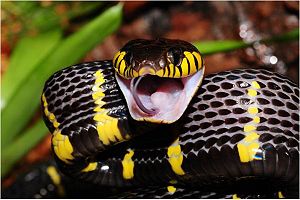Sandbox Reserved 932
From Proteopedia
m |
m |
||
| Line 37: | Line 37: | ||
Denmotoxin shares approximately 30% sequence similarity with other 3FTXs with an exception of exhibiting approximately 50% sequence similarity with another colubrid snake venom α-colubritoxin. Despite the relatively low sequence similarity, denmotoxin possesses all the residues needed to maintain the 3 finger fold. A large part of the sequence similarity between denmotoxin and other 3FTXs is due to the highly conserved disulphides and a number of structurally important residues. | Denmotoxin shares approximately 30% sequence similarity with other 3FTXs with an exception of exhibiting approximately 50% sequence similarity with another colubrid snake venom α-colubritoxin. Despite the relatively low sequence similarity, denmotoxin possesses all the residues needed to maintain the 3 finger fold. A large part of the sequence similarity between denmotoxin and other 3FTXs is due to the highly conserved disulphides and a number of structurally important residues. | ||
| - | Denmotoxin is a monomeric protein comprising of 77 amino acid residues. Denmotoxin consists of <scene name='57/579702/Three_fingers/1'>three polypeptide loops</scene> protruding from the globular core; this structure is typical for 3FTXs. The globular core consists of a | + | Denmotoxin is a monomeric protein comprising of 77 amino acid residues. Denmotoxin consists of <scene name='57/579702/Three_fingers/1'>three polypeptide loops</scene> protruding from the <scene name='57/579702/3ftx_beta_strands/2'>globular core</scene>; this structure is typical for 3FTXs. The globular core consists of a triple stranded anti-parallel β-sheet ; two of the β-strands in this structure connect to the second loop (central loop) and one β-strand connects to the third loop. There are two highly <scene name='57/579702/Flexible_regions/2'>flexible regions</scene> on the protein: one at the tip of the central loop and one at the 3 first residues of the N-terminus; the expected active site of denmotoxin is at the tip of the central loop. |
There are 10 structurally important cysteine-residues in denmotoxin which form five stabilizing <scene name='57/579702/Disulphides/3'>disulphide bonds</scene>. Four of these disulphide bonds, which are found in all 3FTXs are located at the central core and the fifth additional bond is found at the tip of the first loop. The cysteine residues of all 3FTXs are highly conserved, whereas the other residues within the sequence express high variability. Denmotoxin possesses most of the conserved residues invariant among 3FTXs which have been shown to be important for the proper folding of and structure of protein. The presence of these structurally important residues result in the characteristic three finger fold of the toxin (e.g. Gly52, Pro58). | There are 10 structurally important cysteine-residues in denmotoxin which form five stabilizing <scene name='57/579702/Disulphides/3'>disulphide bonds</scene>. Four of these disulphide bonds, which are found in all 3FTXs are located at the central core and the fifth additional bond is found at the tip of the first loop. The cysteine residues of all 3FTXs are highly conserved, whereas the other residues within the sequence express high variability. Denmotoxin possesses most of the conserved residues invariant among 3FTXs which have been shown to be important for the proper folding of and structure of protein. The presence of these structurally important residues result in the characteristic three finger fold of the toxin (e.g. Gly52, Pro58). | ||
Revision as of 18:54, 16 May 2014
| This Sandbox is Reserved from 01/04/2014, through 30/06/2014 for use in the course "510042. Protein structure, function and folding" taught by Prof Adrian Goldman, Tommi Kajander, Taru Meri, Konstantin Kogan and Juho Kellosalo at the University of Helsinki. This reservation includes Sandbox Reserved 923 through Sandbox Reserved 947. |
To get started:
More help: Help:Editing |
B. Dendrophila monomeric toxin (Denmotoxin) is the primary protein of snake venom used by Boiga dendrophila. This colubrid snake lives in Southest Asian lowland rainforest and mangrove swamps using birds as its primary prey.
One of the most well characterized snake venom protein families is the Three-finger-toxins (3FTX). These proteins consist of three β-stranded finger-like polypeptide loops stabilized by four disulphide bridges on the surface of a globular core. In non-convential 3TFXs a fifth disulphide bridge can be present as is the case in Denmotoxin. The crystal structure of denmotoxin was solved to 1.9Å by molecular replacement method.
Denmotoxin binds specifically to bird muscle nicotinic acetylcholine receptors preventing their normal function in signal transduction. This taxon specifity is reached by unique structural differences to other 3FTXs such as changes in the suggested binding loop of the protein.
Denmotoxin
| |||||||||||
Additional Information
References
Pawlak, J.; Mackessy, S.; Fry, B.; Bhatia, M.; Mourier, G.; Fruchart-Gaillard, C.; Servent, D.; Ménez, R.; Stura, E.; Ménez, A. 2006. Denmotoxin, a Three-finger Toxin from the Colubrid Snake Boiga dendrophila (Mangrove Catsnake) with Bird-specific Activity. The Journal of Biological Chemistry: 281: 29030-29041 doi: 10.1074/jbc.M605850200

![Three fingers formed by three peptide loops (F1, F2 & F3) [PDB=2H5F]](/wiki/images/thumb/3/3f/Kolme_sormea_figure_text.png/300px-Kolme_sormea_figure_text.png)
![Suggested interaction of α-bungarotoxin in binding pocket of nAChR (simplified figure) [PDB=4HQP]](/wiki/images/thumb/d/d7/Bungarotoxin_interaction_with_nACHr_figure_text.png/300px-Bungarotoxin_interaction_with_nACHr_figure_text.png)
